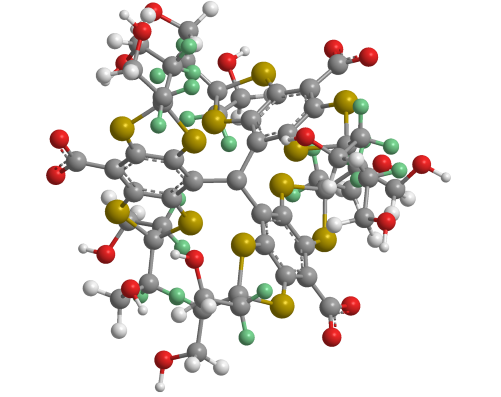Magnetic resonance imaging (MRI) and electron paramagnetic resonance oxygen imaging (eMRI or EPROI) are fundamentally based upon the same principles, however a key difference is the resonant species. MRI aligns water protons, that are abundant in the body, in a magnetic field to produce exquisite anatomical images whereas eMRI relies on aligning electron spins. Unlike the ubiquity of protons, unpaired electrons sensitive to oxygen are rarely found in living organisms. A nontoxic contrast agents, with high specificity and sensitivity to detect molecular oxygen, is a necessity for EPR-based oxygen imaging; and now, it is being synthesized by O2M Technologies. Introducing incredible molecule: OX071!

Tetrathiatriarylmethyl or “trityl” radicals are not unfamiliar in MRI applications. They have been used as a polarizing agent. Previous versions of trityls, such as the largely used Finland trityl (FT), were unsuitable for in vivo experimentation. Its lipophilic core has a propensity to aggregate with plasma proteins, resulting in some amount of toxicity. In the next iteration, trityl OX063, 12 methyl groups in FT are replaced with hydroxyethyl groups, which greatly increased it’s hydrophilicity. The result is a completely non-toxic, injectable probe. OX063 is used a polarizing agent in 13C MRI.
The latest evolution of trityl is OX071, a partially deuterated analogue of OX063. Deuterium is EPR-silent, which eliminates a source of hyperfine coupling with trityl’s radical center. OX071 retains all the benefits of it’s predecessor while also showing a higher oxygen sensitivity, a higher signal-to-noise ratio, and under physiological conditions, a single-line EPR spectrum with ultra-narrow linewidth. OX071 is especially sensitive in low oxygen conditions. Even a small amount of OX071 will generate signal. The probe can be delivered intravenously, intraperitonially or intratumorally. OX071 is cleared from the animal in 10-30 minutes virtually unchanged.
All these properties make OX071 the probe of choice for a wide array of in vivo EPR oximetry experiments. OX071 has already been published in applications of solid tumor oximetry, viability studies in highly oxygen dependent cell populations like transplanted islets of Langerhans, bioscaffold device development, and much more. Reach out to O2M for OX063 or OX071 in your experiments!
